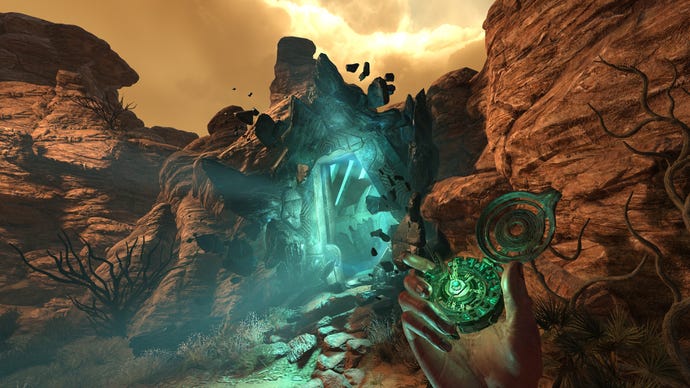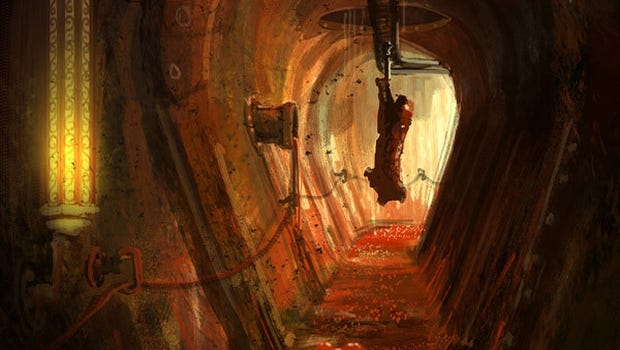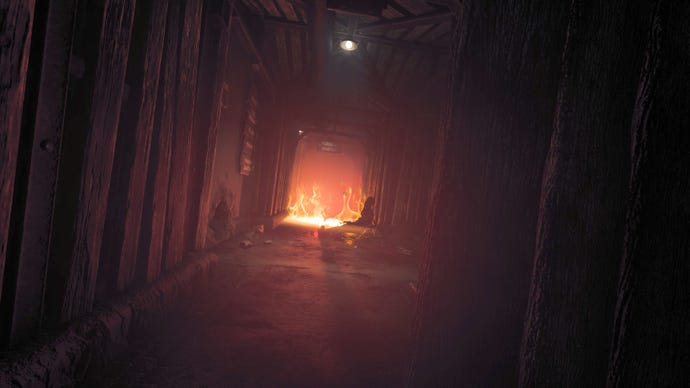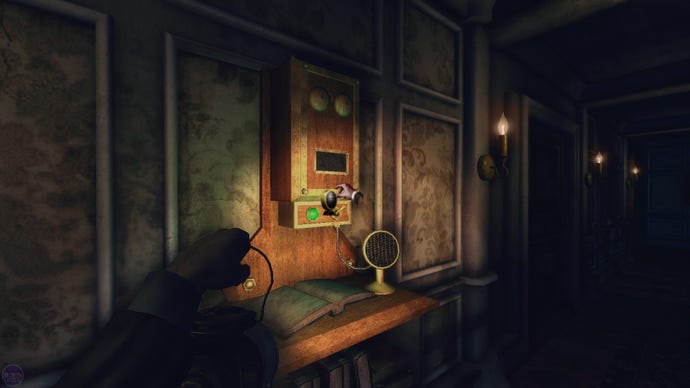Beware major plot spoilers for the entire Amnesia series, together with descriptions of fictional torturing techniques.
The most ghoulish of Amnesia’s many ghoulish ideas is « vitae ». It’s a luminous, blue-green fluid that can be used as an energy source, a chemical catalyst and a supernatural healing agent. Each Amnesia game is broadly a story about the production of vitae, with some levels consisting of huge distillation and refining apparata, and major plot developments tied to what you do with it. In the original Amnesia: The Dark Descent, you’ll brew potions using vitae in order to keep a decapitated head alive. In the latest game, Amnesia: Rebirth, you’ll use ornate metal cannisters of the stuff like batteries to power otherworldly machines. Vitae is the blood and breath of Amnesia, the grease upon the narrative axels, the fuel in its boiler, the miracle McGuffin that sustains its nastier flights of fantasy. But what is vitae, exactly? Agony.
Vitae is a psychosomatic substance extracted from the bodies of tortured beings, and especially, human beings. As Alexander, the antagonist of The Dark Descent, explains in one of the game’s grimmer found documents, it’s generated in response to pain and fear, like the so-called ‘stress hormone’ cortisol. « As long as the body suffers it will continue to produce the vitae and saturate the blood with its properties, » Alexander writes. Obtaining vitae from a person isn’t, however, just a question of brutalising them relentlessly: it takes subtlety. Craft. « Only with careful performance will the victim yield maximum effect. »
youtube.com/watch?v=lbHeM6qJhWw » rel= »noopener » target= »_blank »>Watch on YouTube
« Careful performance » may involve appeals to the imagination. Simply presenting the instruments of torture can be as effective as using them. « The human mind is extremely efficient, as it will trigger itself into greater fear simply by imagining it, » Alexander goes on. The effectiveness of the act itself is a question of pacing and restraint: « while applying pain, make sure to avoid massive damage as it will prove more efficient if the process can be sustained. Also, apply the pain in doses, if possible with breaks to let the body settle. » Even if treated with the utmost delicacy, however, there will come a point when the victim’s resilience is broken and their body is no longer able to produce vitae. In the event, Alexander explains, the extractor can administer a potion of amnesia – the same potion your character drinks at the start of The Dark Descent, in order to free themselves of the knowledge of being a torturer – so as to freshen the victim up for another onslaught.
The word « vitae » recalls « aqua vitae » or « water of life », the name given to ethanol by the 14th century alchemist John of Rupescissa, who thought that this miraculous preservative might be the cure for old age. The concept of a liquid lifeforce calls upon Frictional co-founder Thomas Grip’s wider reading about the history of anatomy and neuroscience, and especially Carl Zimmer’s book Soul Made Flesh. But vitae wasn’t based on any individual experiment or piece of literature, as The Dark Descent’s writer Mikael Hedberg tells me over email. « It was rather a loose reference to the primal idea of life being something beyond the physical body, » Hedberg explains. The game’s developers figured « that when tortured, a person’s will to live flared along their state of panic », rendering their vital energies potent enough to harvest.

In The Dark Descent, which began development when Frictional had just four staff, the extraction of vitae is represented as a one-to-one, hands-on process, a series of occult laboratory experiments, couched in memos to collaborators. In Rebirth, created by a team of 20-30 following the success of Dark Descent and Frictional’s gloomy underwater adventure Soma, vitae extraction has been perfected and turned into a system of mass production. Later in the game, your character Tasi travels to another dimension ruled by an empire that is fuelled by the vitae generated by factories full of lifeforms abducted from other worlds. Here, victims are housed in pods with mechanised attachments, at once automating the torture and anonymising the victims, not least with a view to sparing the sensitivities of the empire’s progressive citizens. As you explore one factory floor, you can see their silhouettes twisting and shrieking under glass.
The premise of a parallel empire sustaining itself on the distilled suffering of creatures stolen from other worlds reflects Grip’s fatalistic view of human history as the steady optimisation of the business of oppression and exploitation, stratified by class and species. « There’s always the boring explanation about where it started out. Like, we need a reason for these people being tortured, so okay, it’s an energy resource! » he says. « But I mean, in a sort of abstract way, people suffering over the years, over a civilization, is an energy resource. It’s an abstraction, but the more you push people, the more energy you can get. It’s sort of fuzzy, it’s not always that way, but over much of history, it’s ‘how much money can I take from this poor farmer before he dies?’ It’s interesting just how prominent a certain amount of suffering is to the human experiment. »
« The way most animals kill other animals is not kind, » Grip goes on. « We humans think we’re gonna kill the animal in a humane way, but a lion in the savannah doesn’t try to kill something as quickly as possible. Fatally wounding is okay, as long as I don’t lose track of it. It takes two hours to die – I can wait, that’s no problem. So you’re optimising. And for humans that comes in at the society level, with factories and so on. The lion is okay with the gazelle bleeding out, and the factory owner is okay with their workers suffering, because this is optimising my labour force. »
The idea of inflicting « a certain amount of suffering » in the name of optimisation could also be a manifesto for horror game design. The Amnesia games often invite comparisons between Alexander’s « careful performance » of vitae extraction and the way they themselves are laid out and paced to stimulate dread and terror. They may not harvest your vitae, but as products, they must operate upon the player in similar ways, and often seem to delight in advertising this.
In Rebirth, you explore a sunken maze, constructed by the architects of the dark world, where genetically engineered Harvesters stalk their victims so as to elicit the maximum fear and produce the maximum vitae. There are lore documents on the creation of this maze that read like tester feedback about mob scripting: one message observes that configuring the maze to allow the monsters to come too close to their victims « does not give enough time for an appropriate build-up of harvestable energy within their systems ».
Is this deliberate self-commentary, I ask Grip? « Not deliberate, but we noticed how similar it was already in The Dark Descent when Alexander goes over his methods, » he says. « It is quite interesting how close torture and making good horror ‘entertainment’ are. While I do not see our games as a metaphor for this, it is a very interesting subject. »

There are also equivalents in Amnesia’s design for the concept of pacing the onslaught and « resetting » the victims of vitae extraction. Like many works of horror, the games offer moments of calm and security to vent some tension and ready you for the next gauntlet of scares – well-lit siderooms that replenish your character’s sanity in The Dark Descent, flashbacks to relatively innocent times in Rebirth, or the administration chamber of Amnesia: The Bunker, with its inexhaustible oil lamp and reassuring metal doors. These safe areas are a form of anaesthesia, cleansing and refreshing the nerves, and the games sometimes play up the association with their own, represented methods of pacification. In The Chinese Room’s Amnesia: A Machine For Pigs, there’s a barracks where you’re permitted to wander and spy on the titular abbatoir’s pitiful, vivisected workforce in safety, all the while listening to the same classical music that, as you learn elsewhere, « calms the product » during its journey along the pigline.
It’s especially unpleasant to reflect that these calculated reprieves might include each game’s opportunities for empathy. Most Amnesia games offer some kind of branching « trolley problem » for the player, with the opportunity to help or harm some helpless NPC – a moment of kindness you must weigh against the cartoonishly awful things your character did, before losing their memories and relinquishing control to the player.
In The Bunker, for example, you have the option of either using an anonymous German prisoner as bait, or putting yourself at risk to spare him while obtaining a pair of pliers from his cell – a way of making amends for the torture inflicted by your comrades, prior to the game’s events. In Rebirth, you can choose to torture a captive for the vitae needed to activate a machine. These scenarios reflect Grip’s career-long interest in how players may be induced to have empathy or lose it, and how they can be brought to understand or forgive acts of wickedness. Showing mercy makes the world of Amnesia feel a little friendlier, like there is something to hope for beyond mere survival, a future beyond the endless return of a terrible past. But you could argue that these windows of optimism are just another way of making you forget the brutality, and softening you up for the next swing of the blade.

« Vitae » production might take inspiration from the alchemist at their crucible, but Amnesia’s self-referential game design offers a pretext for comparison with more recent forms of « energy extraction ». In particular, I want to read vitae as a metaphor for another kind of distilled « lifeforce », digital data. Even before you consider the uses and abuses to which it may be put, data has become an inherently dehumanising and obfuscatory concept. As advocacy group Defend Digital Me argues in a paper calling for « sustainable » data policies, it’s commonly figured as a necrotic fluid akin to a fossil fuel, a valuable but volatile compound that can be drawn off and converted, and which « leaks » from the human body when it is obliged to exist in a predatory surveillance environment.
Treating data as a resource allows us to « see data as something which appears miraculously, free for us to harvest, and not something that is governed and manipulated by humans », the paper notes: it hides the ways in which data is actively produced or gathered by certain parties, much as the moving parts of vitae production are hidden away in Rebirth’s alien factories. Framing data as a leaky body fluid, meanwhile, « centres the individual as someone who is responsible for hiding or protecting their data – otherwise they leave themselves vulnerable to being tracked and targeted ». It tacitly absolves the operators of data-collection platforms of responsibility, while encumbering the user with « a shadow or second self » composed of « residual » data that must be shielded from harm. Much as playing The Dark Descent is sort of an exercise in checking your character’s vitae levels via the game’s sanity mechanics, keeping a lid on Daniel’s fear so as to navigate successfully and escape detection, so we are tasked with managing our own data exposure and looking after our digital doppelgängers when we move through online spaces.
Every videogame can be defined as a data-harvesting device. As this Wired piece contends, there’s a sense in which even games that don’t have networked surveillance mechanisms are about siphoning data from the player – it’s simply how they make sense of us and our actions, boiling us down to inputs and outputs. Among the great crises of our time is that the volume of data collected by games and other consumer surveillance devices such as Facebook or google has become sustenance for a generation of so-called « Artificial Intelligences », which essentially operate by analysing and recombining decades of thought and feeling willingly fed to free-to-access corporate platforms, during the halcyon days of web 2.0.

The Amnesia game that speaks to this crisis most directly is Amnesia: A Machine For Pigs, whose automated slaughterhouse is actually the body of a rogue portion of the protagonist’s own soul – a true artificial intelligence, which collapses social and species boundaries in viewing all other lifeforms as fossil fuel. The Machine is an extraction apparatus without equal, a triumph of « self-regulatory automation », in the words of one found document, which supplants the king and the factory owner at the summit of Grip’s grim description of human civilisation. It goes beyond even Rebirth’s vitae factories in harvesting every part of its victims, from their flesh and blood to the kinetic energy of their struggling bodies as they are transported along the central pigline. It recycles the heat generated by its central processing unit to scald and dehair corpses, and captures methane expelled by those corpses to power its boilers.
This frenzy of optimisation and efficiency recalls Upton Sinclair’s account in his novel The Jungle of how 19th century slaughterhouses « use everything of the pig except the squeal ». But it also captures the exhaustive scope and granularity of modern data-gathering services, with networked videogames especially equipped (if not necessarily permitted) to track everything from how quickly you level-up to your usage of possible slurs in voicechat through changing facial expressions and the electrochemistry of a playtester’s sweat.
A Machine For Pigs is also the ultimate incarnation of Amnesia’s exploration of the overlap between torturous energy extraction and horror game design. Here, the vaunted « critical path » has become a slaughtering line: to reach the game’s end you must repeat the journey of a carcass through the abbattoir, with story beats that might as well be labelled dehoofers, scalders and eviscerators. But the game also portrays this journey as one of self-recovery, with protagonist Oswald confronting his doppelgänger and embracing a second life as a saboteur. While framed in lurid Penny Dreadful style, this theme transcends Amnesia’s grotty fiction and suggests a routine, but far from empty course of revolutionary action: become intimate with the mechanisms of harvesting, whatever form they may take, so as to disentangle ourselves from them and dismantle them from the inside.










